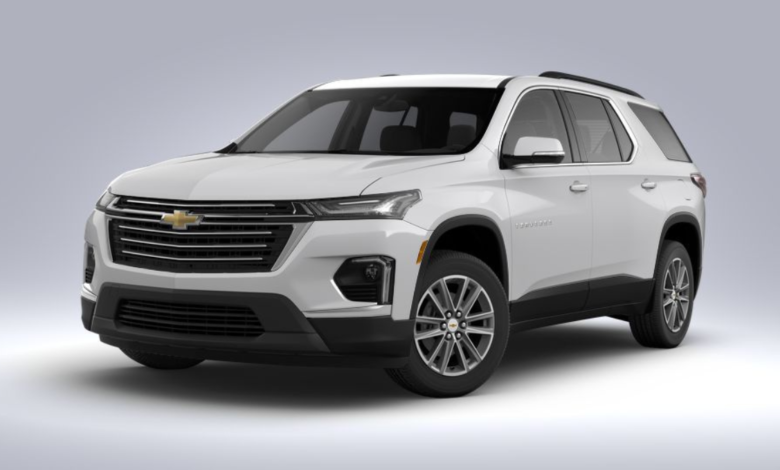
Chevrolet Traverse—with the option of second-row captain’s chairs or a bench—saw a significant redesign in 2022 and is mostly unchanged in 2023. It still has a powerful, sleek appearance, a 3.6-liter V6, and excellent handling and ride quality balance. Its interior capacity is also among the highest in the class.
No, it won’t excite you, but operating this crossover also doesn’t feel like using a large land yacht. The machine’s sturdiness is a pleasure, from the silent cabin to the step-free powertrain. The problem is that the higher grades become more costly. There aren’t a few a la carte alternatives, and other competitors provide far more tech, safety, and infotainment.
The pricing range is $20,000 from top to bottom, with five tiers. Starting at $35,915, the basic LS goes up to $38,440 for the LT Cloth, $42,085 for the LT Leather, $46,885 for the Sporty RS, $49,050 for the Premier, and $53,345 for the top-tier High Country. Adding all-wheel drive varies according to the trim level, from $2,000 to $2600. (A destination charge of $1395 is included in all pricing; manufacturer discounts are not applicable.)
The Ford Explorer has many engine options, including a hybrid one; Toyota’s Highlander, also available with a hybrid powertrain; and the Kia Telluride, the rivals of the Traverse across town. Because Telluride’s décor is less coach-chic and more business-class upmarket, it has established a standard for the class. Another sister of the GMC Acadia, the Chevy Traverse extends over an 8.4-inch larger wheelbase (and 205.9-inch total length) to cross over into the Jeep Grand Cherokee L and Dodge Durango domain.
Nevertheless, the Traverse’s most outstanding feature is its size, which provides exceptional load space and the finest back seat legroom in the class. But all of that is about to change. In mid-2023, Toyota will release the Grand Highlander, providing much greater luggage and third-row room than the current average Highlander. Honda will also be releasing a bigger version of the Pilot in 2023. In this category, the Volkswagen Atlas is also on the larger end of the space range, but it is more expensive, particularly if a V6 is added.
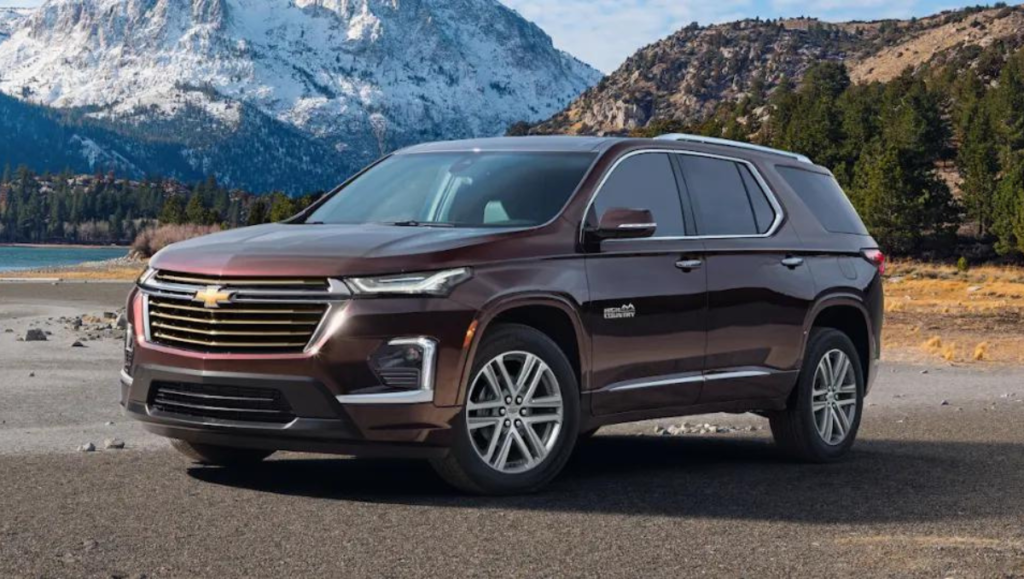
Compared to the Highlander, Explorer, and Telluride, the Traverse has more space without being difficult to manoeuvre. While the Chevy Traverse’s primary goal is not off-roading, some competitors are more suited for it, such as the Grand Cherokee L and the Ford Explorer, which can even go off-road. It’s perhaps the most diminutive, ambitious, off-road crossover SUV. In fairness, most vehicles found in the family crossover market are not classified as rock crawlers.
Is this the proper way to see the Traverse? It’s a spacious, roomy family SUV that drives well and has less social stigma than an off-road vehicle. It resembles a minivan. Avoid delving further into the thought that would bolster it. A $59,540 High Country AWD that is almost wholly equipped won’t transform into a Mercedes by magic. You’re getting tremendous value if you spend burger money rather than steak money.
Performance: Chevrolet Traverse
When matching the nine-speed automated gearbox with the 310 horsepower 3.6-litre V6 engine, the Chevrolet Traverse developers did their research. Shift points are not very noticeable. And although we’ve had desires for paddle shifters and sports cars in various vehicles with automatic transmissions that bang and clang, you never consider such a thing while operating a Traverse. (Use the gear selector switch mounted on the side of the centre console selector if, for example, you’re hauling a trailer or travelling in the snow and need a faster toggle.)
Additionally, it would be best to give Chevy a fist bump for designing a quiet engine. The V6 is smooth both at idle and on the highway, and the gas-saving start/stop system saves fuel in heavy traffic with the same efficiency level as the gearbox. If Kia’s Telluride is the class beauty queen, the Traverse drives like the silent math whiz calmly writing every equation on the board.
Additionally, Chevy precisely adjusts the suspension to eliminate noise from bumps and ruts on the road. This cockpit is perfect for spending hours (probably too many) driving kids to practices—basketball, band, and everything else—because of the smooth ride.
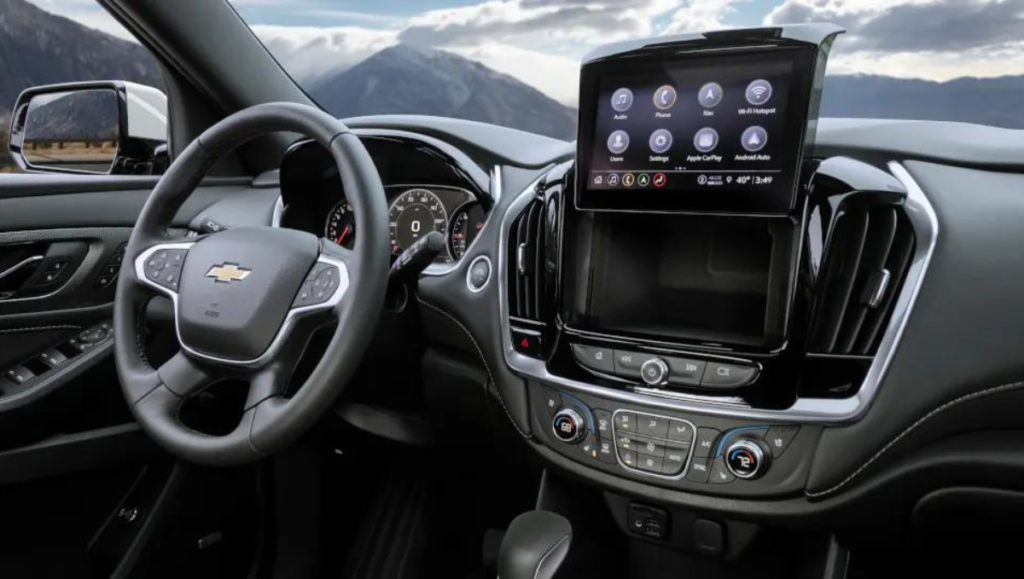
Fuel Efficiency: Chevrolet Traverse
The front-wheel drive Traverse achieves a combined fuel economy of 21 mpg (18 city, 27 highway). Adding all-wheel drive costs a little because fuel efficiency drops to 20 mpg overall, 17 in the town and 25 on the interstate.
Regrettably, competitors that get notably higher city mileage outperform the Traverse. The non-hybrid Highlander is noticeably more fuel-efficient, with 25 mpg combined, 22 mpg in the city, and 29 mpg on the highway (AWD deducts one mpg for every measure). The most fuel-efficient non-hybrid Ford Explorer is the rear-drive turbo four-cylinder model, which achieves 25 mpg combined, 21 mpg in the city, and 28 mpg on the highway.
The Kia Telluride gets 23 mpg combined, 20 mpg in the city, and 26 mpg on the road. Both cars’ AWD variants and luxurious Explorer levels deduct one or two mpg from each statistic. Although the V6 hybrid Explorer has greater power, its highest combined fuel economy is just 27 mpg city and 25 mpg highway.
Suppose fuel efficiency is a significant priority for you. In that case, you might consider the Toyota Highlander Hybrid, which starts at a few thousand more than non-hybridized Highlanders but boasts higher fuel economy—36 mpg combined, or 35 cities and 35 highways.
Once again, the more significant 2023 Honda Pilot is in the works, although the EPA has not yet released official numbers for the model. Nevertheless, the 2022 model achieved better-than-average fuel efficiency in its class.
Driver assistance and safety:
Chevy’s Safety Assist package has several standard safety features, such as automated emergency braking, front pedestrian detection, lane departure warning, automatic high beams, and forward collision warning. However, to add blind spot detection and rear cross-traffic alert, you must upgrade from the $35,915 base LS trim to the $38,440 LT, with a $1,395 destination fee. Buyers cannot get adaptive cruise control until they reach $42,135, and the LT Leather rung is unavailable at that price increase.
Unfortunately, the Kia Telluride LX, which retails for $37,025, already has all these goodies as standard.
The 2023 Traverse receives four out of five stars from the NHTSA (National Highway Traffic Safety Administration) and an overall crash-worthiness rating of “Good” from the IIHS (Insurance Institute for Highway Safety) with a 5-star rating from the NHTSA and a Top Safety Pick Plus from the IIHS, the Kia Telluride triumphs in terms of safety. The Toyota Highlander and the Ford Explorer are Top Safety Pick Plus vehicles.
Coziness & Space:
The Traverse is a large vehicle. One of the main reasons to desire one is because, unlike other cars in the class, every passenger seat feels spacious in both the seven- and eight-seat configurations, and third-row comfort is superb. There is 33.5 inches of legroom in the third row and 38.4 inches in the second. The Telluride has a larger second-row space at 42.2 inches but at the price of the third row, which only has 31.4 inches, while the Highlander measures 38 and just 27.7 inches.
In summary, the Traverse is a strong option if you often need to use the third row.
The Traverse’s interior has plenty of space, including ten cupholders—several oversized—sliding second-row seats, tilting seat backs, and plenty of storage for an American-sized water bottle. The Traverse was built by Americans for American space demands, as seen by the cubbies dotted around the cabin, the storage space in the armrest, and the large bin under the centre stack.
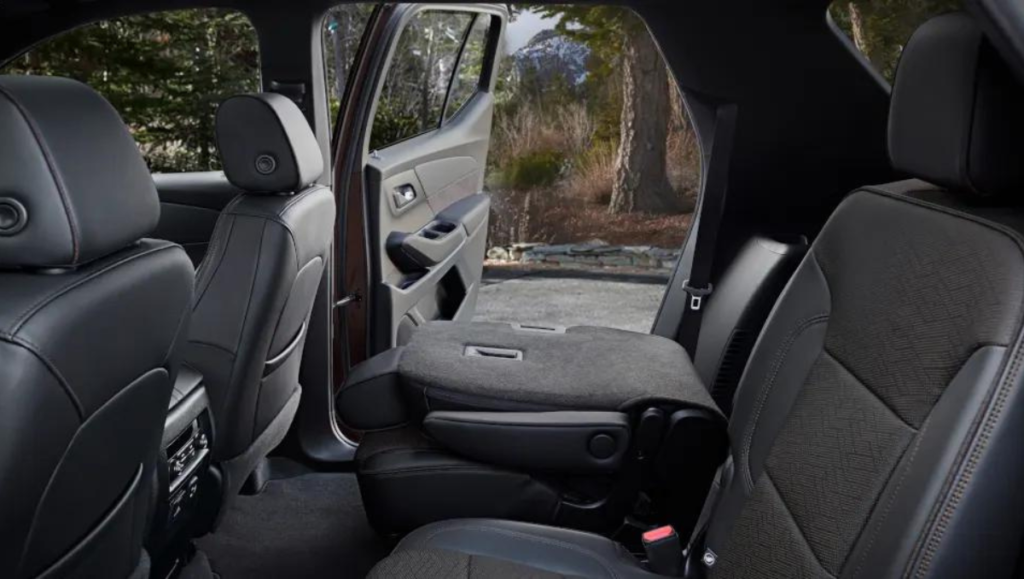
Infotainment: Chevrolet Traverse
Chevy is at least competitive with its competitors thanks to wireless Apple CarPlay, Android Auto, and Wi-Fi availability (albeit at an unavoidable premium). We also like that Chevy’s system still uses physical volume controls and hard buttons for radio/entertainment settings. Chevy packed a lot of features onto the touchscreen. Still, the layout and symbols are pretty easy to use, and the dual driver infotainment controls on the steering wheel allow you to change the sound sources and maintain your eyes on the road without missing a beat (forgive the pun).
Bonus points are also awarded for the six USBs—two for each row—but Telluride has free navigation (the Traverse requires the $47,835 RS level to acquire it), and the Kia’s 12.3-inch touchscreen is far more significant than the Chevy’s 7-inch base display. Parents can outfit the backseat of any Kia, even the basic model, with twin second-row flat screens (along with headphones) for an extra $1,500. This isn’t available on any Chevy model, not even the $53,395 High Country.
The Traverse’s six-speaker sound system is good. Still, if you want the 10-speaker Bose arrangement, you’ll need to upgrade to the RS model or above, precisely the strategy used by Kia, Toyota, and other companies.
Storage & Cargo Space:
A storage container beneath the third row is standard equipment on all Traverse tiers. Three grocery bags may be stacked within this handy box, preventing spills over the rear of your Traverse. We’re not sure why this isn’t standard on every wagon or hatchback, but it’s a fantastic feature that this Chevy has.
More than twice as much cargo space is available when the third row of seats is folded forward—57.8 cubic feet—as when it is in place. 46 and 21 cubes are available in the Telluride, 49.9 and 20.8 in the Explorer, and 48.4 and 16 in the Highlander. When the second and third rows are folded, there are 98.2 cubic feet—ten more than any of the three rivals described before. With an incredible 113.6 cubic feet of space, the new 2023 Honda Pilot is an excellent option for those who require the most room.
The straightforward two-step procedure needed to fold the second row—whether the captain’s seats or the 60/40 bench—makes accessing the Traverse’s cargo area simple.
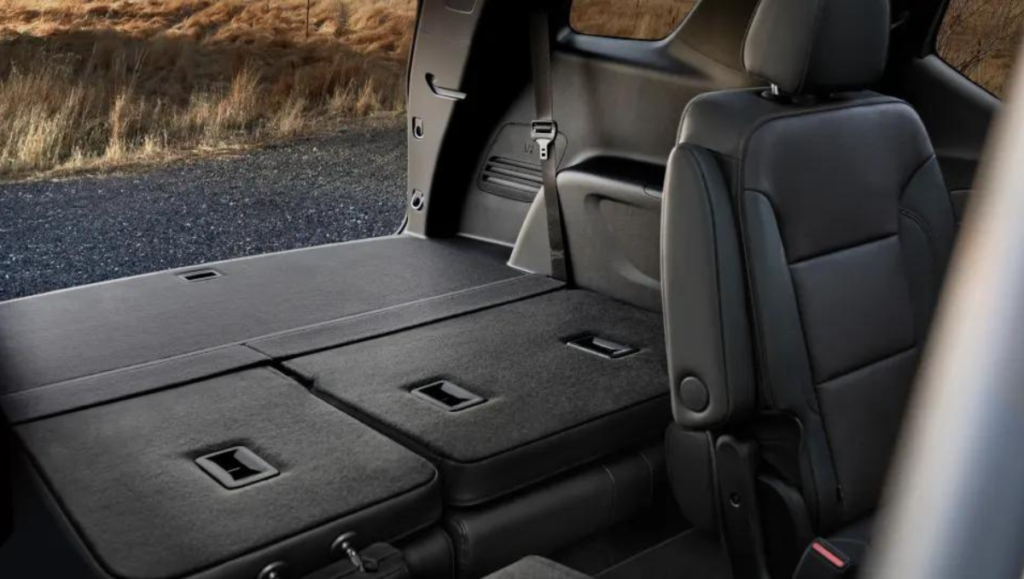
Design: Chevrolet Traverse
The outside of the Traverse is more attractive than the inside. While other automakers stake their claim on building a sturdy off-road vehicle, Chevy is sensibly not attempting to pretend that its three-row SUVs are meant for dirt roads, much less rock crawling. By acknowledging this, Chevy’s designers could adopt a more refined and sleeker design style, ultimately creating an aesthetically pleasing outside but a less stunning inside.
As you get on the famous Telluride, you’ll notice a noticeable improvement in material quality. It may be argued that neither the Ford Explorer nor the Toyota Highlander significantly overtake the Chevy. Still, both the Kia and its kissing cousin, the Hyundai Palisade, cater to a near-luxury market. Like each of those brands, Chevy charges $40–$50,000 or more for the top-tier RS, Premier, and High Country trim levels; nevertheless, even at that price, the quality of the interior materials falls short of what other brands offer.
Which Chevy Traverse is the Best Value?
The most significant value is probably in the $35,915 (prices include the $1,395 destination cost) FWD Chevy Traverse LS. Even with all-wheel drive, the price only increases to $37,915. At $38,440, the LT cloth is appealing because it has amenities like rear cross-traffic warning and blind-spot recognition, which we like in larger cars like this one. The issue is that the price increases to $42,190 if you want AWD by $3,750. For $39,025, you can obtain an AWD Kia Telluride with extra options like adaptive cruise control that the Chevy doesn’t provide.
Indeed, the $39,590 AWD Telluride S also has heated front seats, but no Traverse below the $42,190 LT Cloth model has this feature—which is standard on many vehicles that retail for between $20 and $30,000.
You get more space for your money with the less expensive Traverse versions. The Traverse becomes less and less sensible the more creature amenities you put on. However, people who require a lot of interior space are urged to wait and compare it to the next, larger 2023 Honda Pilot before choosing a Traverse (and putting some more bling on it). The Traverse has a strong motor, a smooth ride, and good handling, but the more you try to turn it into something it’s not, the less competitive it becomes.
How much does insurance cost for a Chevrolet Traverse cost?
Regarding insurance prices, the Chevrolet Traverse is approximately average compared to its rivals. Our research indicates that, across all 50 states, the average yearly premium for a typical 30-year-old female driver with a clean record is $1,900, with the top High Country trim coming in at $2,206. In contrast, the average price of a Ford Explorer is $2,100, a Kia Telluride is $1,999, and a Toyota Highlander is $2,194.
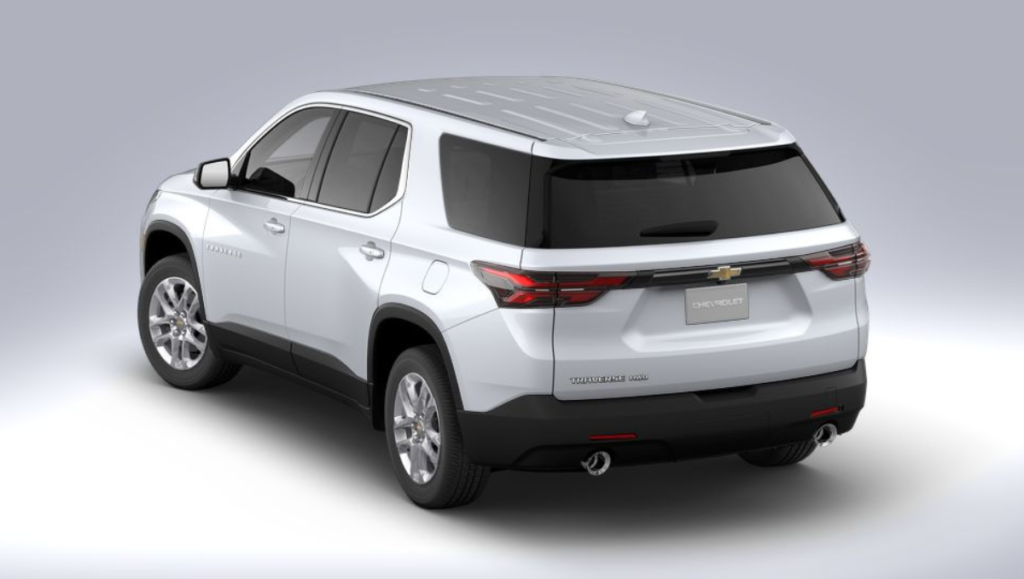
Chevrolet Traverse Generations
Second Generation
2018 to Present
The 3.5-liter V6 engine of the second-generation Chevrolet Traverse made its debut in 2018 when it was mated to an eight-speed gearbox. The eight-speed gearbox was replaced with a 10-speed one in 2020, and the 2022 model year included a slight redesign of the appearance and a new arrangement of the trim levels.
First Generation
2009 to 2017
Although not outstanding, the first-generation Traverse was adaptable, sharing a basis with the GMC Acadia and Buick Enclave. Its five-star NHSTA safety rating, unobtrusive appearance, and space for seven people and their belongings appealed to families that couldn’t commit to the minivan lifestyle. A six-speed automatic and V6 powertrain offered respectable economy. For the 2013 model year, the Traverse got a minor redesign, new infotainment choices, and a revamped shift mapping.
Verdict
The Traverse is a classy and comfortable family car that doesn’t try to be more challenging than it is. It’s even attractive. This eight-seater is among the smoothest available for less than forty thousand dollars and drives with skill, if not sportingly. But that’s the key. Elevating the Traverse’s trim level and adding more options pushes it beyond its comfort zone and into a price range where it appears somewhat false. Choose fewer choices, however, since many are included, and you’ll still have one of this class’s roomier, more manageable computers for a fair price.




